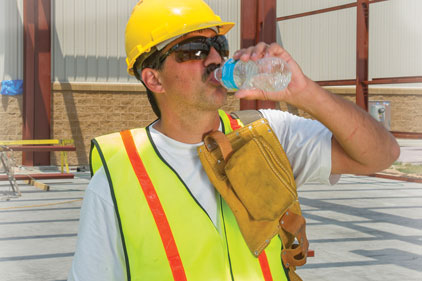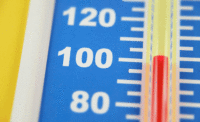One is the body’s ability to handle extreme heat even though there may be a wide range of heat tolerance between workers. When a body is unable to maintain a normal temperature and is pushed beyond its limits, heat-related illnesses and/or death can result.
Preparing for work in high temperatures and humidity, under direct sunlight, or in areas with limited air movement not only requires an understanding of the tasks involved, but also the steps that must be taken to eliminate or reduce heat-related hazards before exposure occurs. Planning ahead for hot weather and making sure that the appropriate precautionary measures are in place before work begins are critical components in preventing workers from reaching their physical limits.
What’s the plan?
The best way to prevent heat-related illnesses is to make the work environment cooler. This can be accomplished in a variety of ways through the use of engineering and/or administrative controls.
Create shaded rest areas: In outdoor environments, choose or create rest areas that provide shade preferably where surfaces are not warm from earlier sun (e.g., north-facing wall), and where the space is opened to cooling breezes. Shade can be provided by buildings, canopies, lean-tos, or other partial or temporary structures that are either ventilated or open to air movement. Trees and dense vines can also provide shade if they substantially block the direct sunlight.
The rest area should also be free of other hazards (e.g., moving traffic, excessive noise, falling objects), have sufficient space for the number of workers needing rest breaks at one time, and be near a supply of cool drinking water.
Reduce indoor temperatures: Hot weather can also affect temperatures indoors by heating buildings and surfaces making operations involving heat even hotter. Providing reflective shields to redirect radiant heat, insulating hot surfaces, and decreasing water vapor pressure by sealing steam leaks and keeping floors dry are just a few methods that can be effective in reducing the transfer of heat in indoor work environments.
Another method to consider is reducing the temperature of the air through the removal or reduction of heat. Air conditioning, increased ventilation, and local air cooling can be effective in making the work environment cool. Fans, which can increase air speed over a worker’s skin, can improve the body’s heat exchange with the environment.
Monitor weather reports daily and schedule jobs for cooler times of day: The National Weather Service issues several types of heat-related updates depending on the heat index, which alert people to extremely hot conditions. These take the form of:
- Excessive heat outlooks when the potential exists for an excessive heat event in the next 3-7 days,
- Excessive heat watches when conditions are favorable for an excessive heat event in the next 24 to 72 hours, and
- Excessive heat warning/advisories when an excessive heat event is expected in the next 36 hours. A “warning” is used for conditions posing a threat to life or property. An “advisory” is for less serious conditions that cause significant discomfort or inconvenience and, if caution is not taken, could lead to a threat to life and/or property.
Monitoring weather reports daily and rescheduling jobs with high heat exposure to cooler times of the day is important. It could also be used to determine how weather information will be used to modify work schedules, increase the number of water and rest breaks, or cease work early if necessary.
Be extra cautious during heat waves when air temperatures rise above normal. When possible, schedule routine maintenance and repair projects for cooler seasons of the year.
Provide reflective clothing: Reflective clothing, which can vary from aprons and jackets to safety vests to suits that completely enclose the worker from neck to feet, can stop the skin from absorbing heat directly from the hot source. But since most reflective clothing does not allow air exchange through the garment, the reduction of radiant heat must more than offset the corresponding loss in evaporative cooling. This means that reflective clothing should be worn as loosely as possible. In situations where radiant heat is high, cooling vests, wetted clothing, water-cooled garments and personal cooling systems can be comfortable and effective.
Other measures
Develop an acclimatization schedule: A properly designed and applied acclimatization program can decrease the risk of heat-related illnesses. This program involves exposing employees to work in a hot environment for progressively longer periods. For workers who have had previous experience in jobs where heat levels are high enough to produce heat stress, it is recommended that the regimen be 50% exposure on day one, 60% on day two, 80% on day three, and 100% on day four. For new workers who will be similarly exposed, the regimen should be 20% on day one, with a 20% increase in exposure each additional day.
Implement work/rest schedules: Distribute the workload evenly over the day and incorporate work/rest cycles, rather than exposing employees to heat for extended periods of time during the course of a job. Work/rest schedules are often based on 1-hour cycles and might call for a rest period of 15 minutes every hour during hot weather, but 45 minutes per hour when temperature and humidity are extreme. Individual requirements may vary greatly.
Make provisions for drinking water: Provide workers with plenty of cool drinking water in convenient, visible locations close to the work area. Remind workers to frequently drink small amounts of water before they become thirsty to maintain good hydration. During moderate activity, workers should be able to drink about 1 cup every 15 to 20 minutes.
Train employees: Train workers and supervisors about the hazards leading to heat illness. This includes educating employees on the risk factors, how to recognize common signs and symptoms, prevention procedures, reporting process, and procedures to follow when responding to possible heat-related illness or contacting emergency medical services.
Create emergency action plan for heat-related illnesses: Have an emergency plan in place that specifies what to do if a worker has signs of heat-related illness, and ensure that medical services are available if needed.
Final thoughts
Planning ahead for hot weather and making sure that the appropriate engineering and administrative controls are in place before work begins are critical components in preventing workers from reaching their physical limits. Understand job tasks and identify hazards, but also take steps to eliminate or reduce the hazards before exposure occurs.








